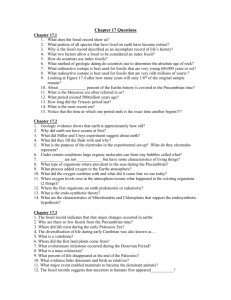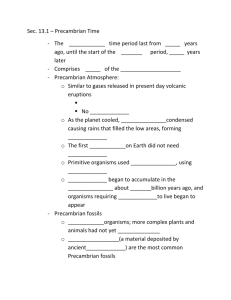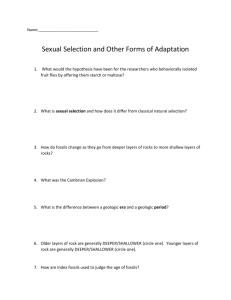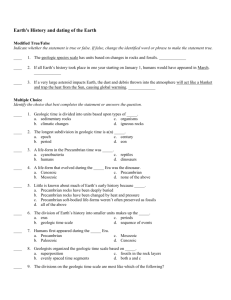Geologic Time Webquest
advertisement
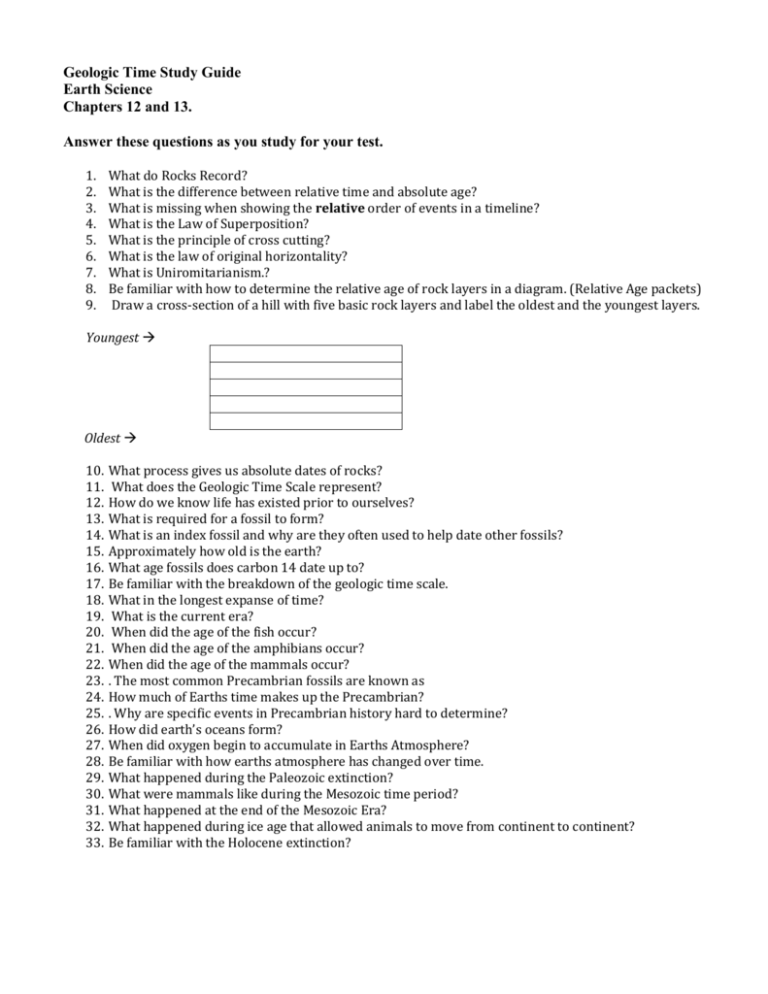
Geologic Time Study Guide Earth Science Chapters 12 and 13. Answer these questions as you study for your test. 1. 2. 3. 4. 5. 6. 7. 8. 9. What do Rocks Record? What is the difference between relative time and absolute age? What is missing when showing the relative order of events in a timeline? What is the Law of Superposition? What is the principle of cross cutting? What is the law of original horizontality? What is Uniromitarianism.? Be familiar with how to determine the relative age of rock layers in a diagram. (Relative Age packets) Draw a cross-section of a hill with five basic rock layers and label the oldest and the youngest layers. Youngest Oldest 10. 11. 12. 13. 14. 15. 16. 17. 18. 19. 20. 21. 22. 23. 24. 25. 26. 27. 28. 29. 30. 31. 32. 33. What process gives us absolute dates of rocks? What does the Geologic Time Scale represent? How do we know life has existed prior to ourselves? What is required for a fossil to form? What is an index fossil and why are they often used to help date other fossils? Approximately how old is the earth? What age fossils does carbon 14 date up to? Be familiar with the breakdown of the geologic time scale. What in the longest expanse of time? What is the current era? When did the age of the fish occur? When did the age of the amphibians occur? When did the age of the mammals occur? . The most common Precambrian fossils are known as How much of Earths time makes up the Precambrian? . Why are specific events in Precambrian history hard to determine? How did earth’s oceans form? When did oxygen begin to accumulate in Earths Atmosphere? Be familiar with how earths atmosphere has changed over time. What happened during the Paleozoic extinction? What were mammals like during the Mesozoic time period? What happened at the end of the Mesozoic Era? What happened during ice age that allowed animals to move from continent to continent? Be familiar with the Holocene extinction? Geologic Time Study Guide Earth Science Chapters 12 and 13. Answer these questions as you study for your test. 1. 2. 3. 4. 5. 6. 7. 8. 9. What do Rocks Record? What is the difference between relative time and absolute age? What is missing when showing the relative order of events in a timeline? What is the Law of Superposition? What is the principle of cross cutting? What is the law of original horizontality? What is Uniromitarianism.? Be familiar with how to determine the relative age of rock layers in a diagram. ( Relative Age packets) Draw a cross-section of a hill with five basic rock layers and label the oldest and the youngest layers. Youngest Oldest 10. 11. 12. 13. 14. 15. 16. 17. 18. 19. 20. 21. 22. 23. 24. 25. 26. 27. 28. 29. 30. 31. 32. 33. What process gives us absolute dates of rocks? What does the Geologic Time Scale represent? How do we know life has existed prior to ourselves? What is required for a fossil to form? What is an index fossil and why are they often used to help date other fossils? Approximately how old is the earth? What age fossils does carbon 14 date up to? Be familiar with the breakdown of the geologic time scale. What in the longest expanse of time? What is the current era? When did the age of the fish occur? When did the age of the amphibians occur? When did the age of the mammals occur? . The most common Precambrian fossils are known as? How much of Earths time makes up the Precambrian? Why are specific events in Precambrian history hard to determine? How did earth’s oceans form? When did oxygen begin to accumulate in Earths Atmosphere? Be familiar with how earths atmosphere has changed over time. What happened during the Paleozoic extinction? What were mammals like during the Mesozoic time period? What happened at the end of the Mesozoic Era? What happened during ice age that allowed animals to move from continent to continent? Be familiar with the Holocene extinction?


